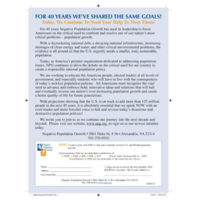The Sources of Unemployment
- Lindsey Grant
- February 1, 2012
- Forum Papers
- 0 Comments
Debt as a Non-Solution. At every level, from government to entrepreneurs and speculators, to households, we have come to rely increasingly on debt. A rising national debt is not a cause of unemployment so long as it works, but at some point – now – it becomes a danger rather than a convenience. It ties our hands as we try to deal with the unemployment crisis. U.S. fiscal policy has gotten us so far in debt that “fiscal stimulus” programs to generate employment, or long term help to the unemployed, risk driving inflation if economic activity does rise, and it could get away from us.
The country went off the gold standard in 1933 and substituted “managed currency“ – i.e. fiat money. When capitalism found ways to encourage growth by generating paper money, it couldn’t stop. The United States’ federal debt has grown from $116 billion in 1930 to $15.27 trillion now – a 130-fold expansion. It seemed to work for a time because of inflation – we pay interest on the debt in depreciating dollars. (A dollar now is worth less than 7 cents in 1930 dollars.) And because of economic growth during the energy boom.
… but not forever. We lecture Europe about its debts and temporize about our own. Our debt was 18% of GDP in 1930; it has now passed 100%. Compare that to the percentage figures for the ostensible fiscal malefactors: Japan at 240%, Greece at 143%, Italy at 119%, Portugal at 93%, Spain at 60%. France, at 82%, has just been downgraded by credit rating agencies, to join us. (The Maastricht Treaty sets a maximum of 60% for European Union members but cannot enforce it.)
Policy makers pretend they are practicing Keynesian economics. It is a false claim. Keynes envisaged a cyclical pattern of budget surpluses in good times and deficits to encourage growth in recessions. Since 1960, the Federal budget has showed a surplus only in the last three years of the Clinton administration.
The electorate went along. As a nation, we want the Government to do everything for us, but we don’t want to pay for it. There are good things we can’t afford, like Medicare, unless we are willing to raise taxes. There are bad things we can’t afford, such as the Vietnamese war and “nation building” in Afghanistan and Iraq.
Government takes the easy path. In good times, it is hard to pass austerity measures or higher taxes. “Why rock the boat?” In bad times: “this is no time for austerity.”
Well-meaning Democrat-leaning economists such as Paul Krugman seem also to have forgotten Keynes’ advice. They are calling for looser money, to revitalize the economy, promote economic growth and mitigate unemployment. Their hearts are in the right place, but their thinking is in the wrong century. Fifty years ago, that would have been good advice, but that was when our debt was far lower, and we were in the midst of the oil boom. Now, as our Federal expenditures (at $1.3 trillion) outrun income by 50%, our national debt passes $15 trillion, and food and commodity prices rise, we don’t have that option. We have reached a point on the planet where physical growth is constrained by the unavailability or increasing cost of the resources on which we depend. Pouring paper money into a limited physical system raises the price of the resources. If we continue an expansionist fiscal policy in pursuit of the illusion of limitless economic growth, we run the risk of generating uncontrollable inflation and soaring interest rates, instead. Paper money, unbacked, is worth as much or as little as people think it is worth. Even now, the dollar holds its value because we are the only game in town – aside from some limited havens such as Switzerland. Money is unlikely to take flight to the Euro, right now.
Meanwhile, the Federal Reserve can increase the supply of money without limit. The Fed is the final arbiter and creator of dollars. It has nearly quadrupled its holdings of public and private debt, and perhaps much more, since 2007.7
Investment banks have been making loans with little or no backing, thereby expanding the credit in the system. Banks that loan $5 for every dollar they own (5:1 leverage) were considered prudent. By 2007, some investment banks and funds were operating with leverage of 35:1. They invented “securitized” mortgage packages a few years ago. It was a fraud because they bundled dubious mortgages – debts – into saleable packages and called them assets. And that further multiplied the fictitious assets in the system. Competition drove the excesses, as well as greed. In a competitive market, leverage pays, and those who don’t keep up lose their investors.
- Feminism, Migration, And Population Policy: A Letter To My Friends - October 25, 2018
- TWO WHITE HATS (An NPG Footnote) - September 23, 2014
- THE TWO CHILD FAMILY - September 22, 2014

